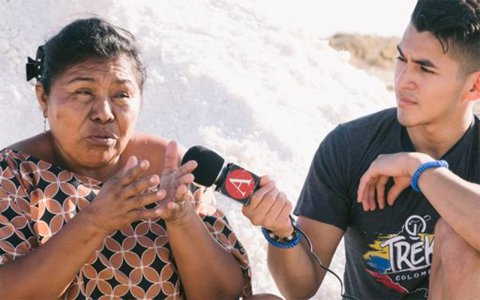“What’s the first thing you want to do when you have electricity?,” asks USC Annenberg student Sam Wen.
“Freeze ice. So, I can keep my fish, my food,” responds María Luisa Barliza Ipuana, leader of the Indigenous Wayuu community of Arema in La Guajira, Colombia.
Wen, along with three other USC Annenberg students and faculty members Amara Aguilar and Andy Keown, teamed up with nonprofit GivePower to document the lives of Arema residents like Ipuana and the impact of bringing sustainable energy to the remote desert location for the first time.
“We spent a week not only working in the community to install solar panels and bring electricity to the village, but we also learned about the families that live there, the women who are leaders of the village, how advancements in technology are affecting traditions and how the community is doing an amazing job of preserving tradition while being progressive as well,” said Aguilar, associate professor of professional practice in journalism.

(Photo courtesy of Andres Guadron Cerna)
While on the ground in Colombia, students captured hundreds of audio and visual assets and conducted one-on-one interviews with local community members to create a wealth of content on various topics from cultural stories to issues around the environment for the organization to use in reaching future stakeholders.
GivePower is one of more than a dozen nonprofits that the school’s Annenberg Agency has collaborated with since 2020. Through micro-internships USC Annenberg students share their digital content creation, public relations, crisis communication, brand communication, and marketing and research skills as consultants.
“Normally, the main focus for GivePower is to develop clean water and energy systems for communities around the world, however, bringing the students to Colombia and incorporating the agency provided a unique opportunity to share a fresh perspective with the organization about what happens on these treks,” said Keown, adjunct instructor of public relations. “The students brought digital cameras, their cell phones, and professional equipment to help chronicle the experience.”
Students learned to better understand climate change issues and how to elevate the voices of people in the community. “One of the biggest highlights for us was capturing stories and sharing with the world how solar energy is going to affect the daily lives of the people there,” senior journalism major Andres Guadron Cerna said.
In addition to gathering media and drafting articles, the team played an essential role in helping to install the new solar energy system for the town. Electricity in the central part of the village now provides lights for women to weave later into the night and outlets for a new sewing machine donated by GivePower. Two new freezers and a refrigerator will allow fishermen to store and sell more fish. All of this helps the village’s residents improve their productivity and income.
“There were so many great stories that came out of this trip but spending the day on a fishing boat and helping the students with their story revealed that everything the fisherman used was handmade,” Keown said. “Being able to document their ability to navigate by sight and the effects climate change is having on the community was very important and fulfilling.”
Next, the Annenberg Agency collaboration with GivePower will continue as students help to translate the media and create a marketing strategy to help expand GivePower’s reach as they scout additional solar installation projects in South America.
“It was just really beautiful to see some of the work come to life and the community come together,” Aguilar said. “We got to know and love the community in just five days. They were like family by the end of the trip and when we turned on the lights everybody was hugging and some people were crying. It was really hard to leave and it was just an amazing experience.”
This trek was made possible by a generous gift from Laura Fox and Ben Vandebunt.
